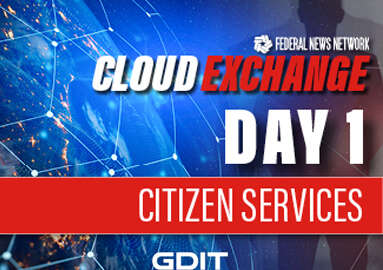
Cloud Exchange: Accelerating citizen services through cloud adoption
This discussion with Ravi Raghava, the chief technology officer for the cloud center of excellence at GDIT, is part of Federal News Network’s Cloud Exchange.
To modernize IT and move to the cloud, agencies need a strategy that sets milestones and prepares the workforce for change management.
Ravi Raghava, the chief technology officer for the cloud center of excellence at GDIT, said agencies need to manage their people, processes and technology as part of any move to the cloud.
“Cloud is here to stay, and cloud is an enabler for business. Cost benefits from cloud are significant, and government customers should have a strategy to migrate their workloads to the cloud and bring more and more services to the cloud,” Raghava said on Federal News Network’s Cloud Exchange.
Raghava said the federal government’s “Cloud Smart” strategy has led to more agencies embracing software-as-a-service (Saas) and platform-as-a-service (Paas) solutions.
“Cloud is always offering the cost benefits, the innovation [and] helping customer[s] innovate at a much faster pace,” Raghava said.
GDIT is providing the subject-matter expertise to agencies to help them successfully migrate to the cloud and retire their legacy IT systems.
Among its customers, GDIT helped the National Institutes of Health’s National Library of Medicine assess its workloads and create a roadmap of applications to migrate to the cloud.
Raghava said GDIT also helped facilitate data exchanges between two financial agencies seamlessly because they were both on the same cloud platforms and following the same standards.
“Our government customers want collaboration, but they need to do so in compliance with all the federal mandates and regulatory requirements. So in that context, you need to have a common set of tools, standards and frameworks to facilitate that,” Raghava said.
Raghava said GDIT also helped provide cloud infrastructure to the Centers for Medicare and Medicaid Services, which allowed the agency to process data faster and with minimal impact on its workforce.
This cloud infrastructure allows CMS development teams to test infrastructure before it goes live, and conduct data quality testing at a much faster pace.
By moving to the cloud, Raghava said CMS was able to reap more than $1 million in annual savings by reducing its “digital debt” and retiring legacy IT systems.
But retiring legacy systems doesn’t just require a technical solution. Agencies need to adopt organizational change management practices to modernize the workforce along with IT.
Raghava said that change management applies to employees at all levels of seniority. Long-tenured employees retain the institutional knowledge necessary to maintain legacy IT, while new hires provide expertise in the latest tech trends.
Agencies, he said, should have a plan to upskill their workforces, whether that means providing current employees with opportunities to learn new skills or recruiting subject-matter experts from outside the organization.
“There’s certainly nervousness when it comes to [organizational change management]. There is nervousness on the existing staff and their institutional knowledge going away, because an agency has adopted the cloud. So this is where agencies have a very important job to upskill their force. So bring in the required support mechanism and offer them training — give them skills and get them certified in cloud. That is definitely going to help,” he said.
While nearly all agencies are moving to the cloud, there’s no one right way to do so.
Raghava said some agency customers start out by moving to a single cloud, which gives them an opportunity to standardize processes and tools. But, he added, some agencies are moving to a multi-cloud or hybrid cloud model in an effort to increase resiliency.
“What customers can gain from a multi-cloud is essentially avoiding vendor lock-in. You are not putting all eggs in one basket. And from an agnostic perspective, you can have solutions that work on multiple clouds. That brings in the required resiliency [and] redundancy that you need. You can have an ecosystem that’s highly available, and that’s not necessarily dependent on one cloud,” he said.
Regardless of what an agency’s cloud infrastructure looks like, Raghava said all agencies should consider a phased approach to modernization.
“You’re not taking a big-bang approach. Rather, you are actually taking smaller chunks, and then migrating them to the cloud in a way that gives your customers the confidence that their applications are going to work well in the cloud. You can learn a lot about how your workloads are functioning, you’re also tailoring and fine-tuning some of the processes that you have. So you’re creating more standard operating procedures, a secure way of operating things in the cloud, having the guardrails that are needed [and] establishing standards,” he said.
Agencies looked to cloud infrastructure for resiliency and increased bandwidth during much of the COVID-19 pandemic. Looking ahead, Raghava said that government demand for cloud services will continue to accelerate.
“For this year and the next couple of years, cloud enablement, cloud adoption and accelerated workload migration to the cloud is going to be the mantra,” he said.
Raghava said agencies will also accelerate their adoption of artificial intelligence and machine learning tools to enable faster insights into their data.
“Government agencies are sitting on a lot of data. We have seen petabytes of data being there. The use of AI and machine learning can facilitate agencies to process their data much faster. And they can get the desired outcomes by leveraging those services, tools and technologies,” Raghava said.
Copyright © 2025 Federal News Network. All rights reserved. This website is not intended for users located within the European Economic Area.
Jory Heckman is a reporter at Federal News Network covering U.S. Postal Service, IRS, big data and technology issues.
Follow @jheckmanWFED





